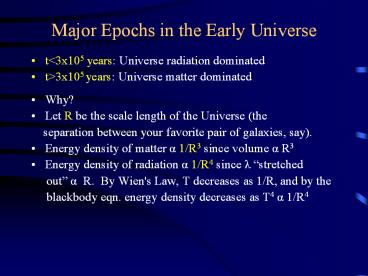Major Epochs in the Early Universe PowerPoint PPT Presentation
Title: Major Epochs in the Early Universe
1
Major Epochs in the Early Universe
- tlt3x105 years Universe radiation dominated
- tgt3x105 years Universe matter dominated
- Why?
- Let R be the scale length of the Universe (the
- separation between your favorite pair of
galaxies, say). - Energy density of matter a 1/R3 since volume a R3
- Energy density of radiation a 1/R4 since ?
stretched - out a R. By Wien's Law, T decreases as
1/R, and by the - blackbody eqn. energy density decreases as
T4 a 1/R4
2
Unification of Forces
- All four fundamental forces of Nature unified at
tlt10-43 s, the Planck time. - Gravity froze' out separate from the other three
forces at this time. - Next the strong nuclear force froze out at
t10-35 s - Weak and electromagnetic forces unified until
t10-12 s - Electroweak unification confirmed in the
laboratory during the 1980s at CERN particle
accelerator in Europe.
3
(No Transcript)
4
Baryon Asymmetry
- Extremely hot radiation in the few seconds after
the Big Bang - Very energetic photons ? continuous interchange
of radiation into matter and vice versa (via pair
production and pair annihilation). - Observable Universe is made up of mostly matter
(as opposed to anti-matter) - Implies a slight asymmetry between matter and
anti-matter in the very early Universe (a little
more matter than antimatter) - This is referred to as the baryon asymmetry' of
the Universe..
5
Confinement and Recombination
- Quarks are the basic particles that protons and
neutrons are - thought to be composed of.
- t10-6 sec (T1013 K), quarks were able to
combine to form protons and neutrons ? the epoch
of confinement. - After t 3x105 years the temperature dropped to
T3000 K - Protons and electrons (and neutrons) were able to
combine to form neutral atoms. - Matter and radiation practically ceased to
interact with each other (i.e., the Universe
became transparent to radiation ? CMBR). - The epoch of decoupling of matter and radiation
or the epoch of recombination.
6
(No Transcript)
7
Big Bang Nucleosynthesis
- Almost all the hydrogen we see in the present
Universe was formed at the epoch of recombination
- Most of the light elements (helium, deuterium,
lithium, etc.) were formed shortly thereafter - The efficiency with which these light elements
were formed depends on what the density of
protons and neutrons was (baryonic matter). - Studying the abundance of light elements
(relative to hydrogen) is a good way of
determining the baryon content of the Universe. - There is a fairly strong indication that most of
the matter in the Universe is non-baryonic, in
addition to being non-luminous.
8
The CMBR Horizon Problem
- The CMBR has the same properties in all
directions. - Consider two portions of the Universe from
opposite ends of the sky. - These two portions are within our observable
Universe (horizon), but they are outside each
other's horizons. - Light has not yet had time to travel from one of
these portions to the other. - If they have never been in communication, how do
they know to be at the same temperature?
9
Inflation
- Very early phase of extremely rapid expansion
(Guth, Linde, 1980s). - During this inflationary phase, the Universe
expands by a factor of 1050 in the time span t
10-35 sec to t 10-24 sec. - Inflationary phase is immediately after the epoch
at which the strong nuclear force froze out, and
before the weak nuclear force and electromagnetic
force froze apart from each other. - All of our observable Universe was an
infinitesimally small volume 1050x1050x1050
10150 times smaller than we would have guessed
from a simple extrapolation of the expansion we
observe today.
10
Solving the Horizon Problem
- Two parts of the Universe on opposite sides of
the sky now outside each other's horizons. - Prior to inflationary epoch, these two patches
would have been within each other's horizons and
therefore known' to acquire the same
temperature. - Inflation caused them to expand out of each
other's horizon. - Inflation requires the universe to expand faster
than the speed of light. - Does not violate special relativity STR only
applies in flat spacetime (i.e., in weak
gravitational fields) - Special relativity is a special case of General
relativity inflation does obey the equations of
General relativity.
11
Inflation, continued
- Why is the density of the present Universe so
close to - critical (or why is the geometry of the
observable Universe so close to flat)? - The scale of the observable Universe is much
smaller than its radius of curvature'. - What causes the rapid expansion during the
inflationary era? - Inflation may be thought of as a phase transition
in the Universe (as in a transition from a liquid
to solid phase). - The latent heat' in this phase transition builds
up into an extremely high vacuum energy density,
and this drives the expansion (analogous to the
repulsive effect of Einstein's - cosmological constant ?).

